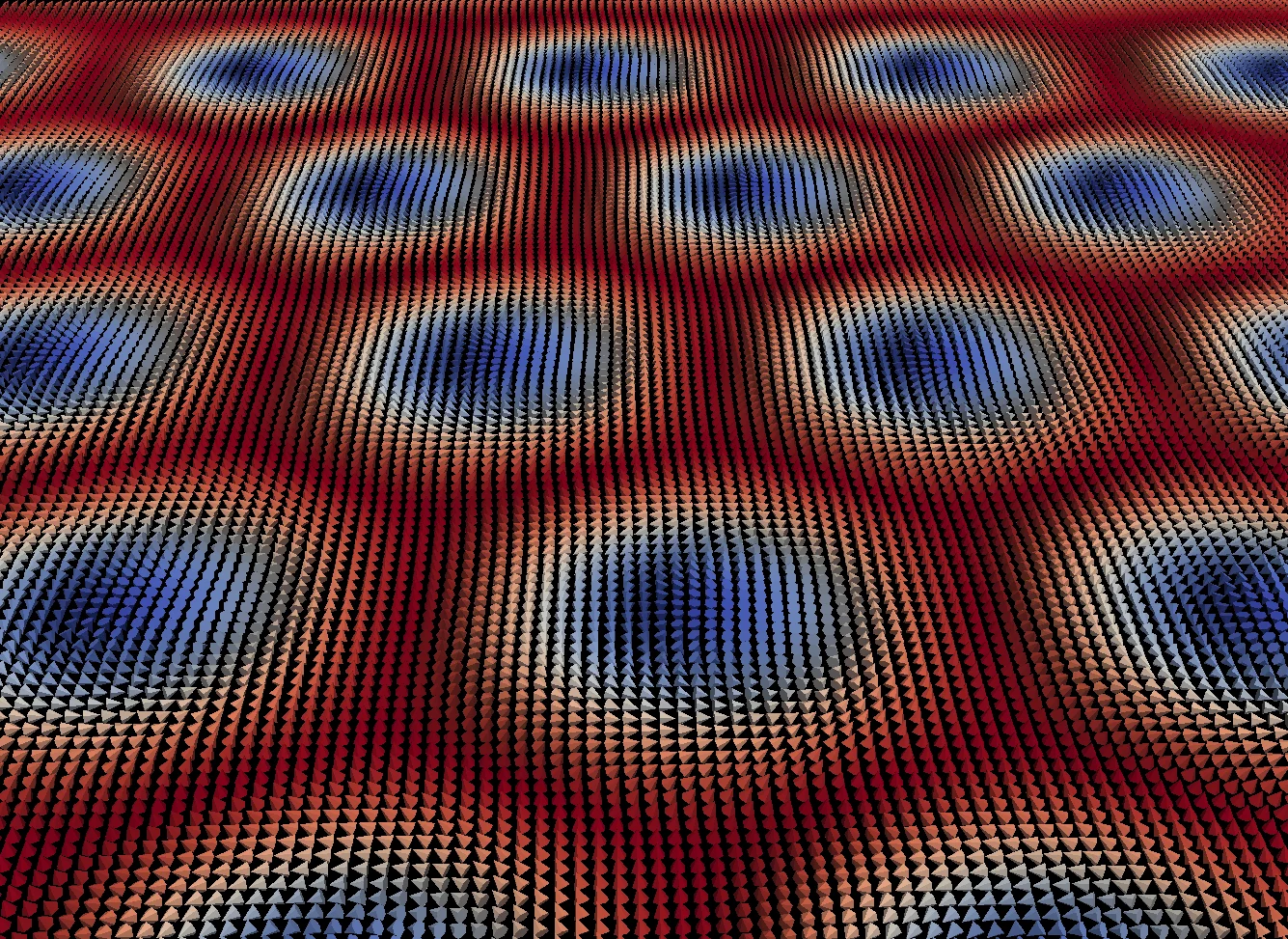To meet the technological demands of a sustainable and safe society, functionalities derived from emergent many-body phenomena in quantum materials will play a key role. For high density and low energy consumption information technologies, new device paradigms based on topological magnetic structures such as skyrmions and hedgehogs are highly promising. What limits the development of such devices at present is both a general shortage of suitable host materials, as well as gaps in the fundamental understanding of the behaviour and stability of topological magnetic order. In this project, we aim to discover, characterize and control skyrmions and skyrmion phases, in both bulk and low dimensional materials.
Magnetic skyrmions – as shown in Figure 1 - are particle-like twists of a magnetization field described by a topological invariant. This distinguishes skyrmions from non-topological magnetic order such as ferromagnetism, and endows skyrmions with a robust stability against external perturbation. Whether topological magnetic structures find use in applications depends on them displaying thermal stability near room temperature, a nanometric size ideally below 10nm, and easy controllability by external stimuli such as weak electric currents or fields. Some of the known host materials satisfy some of these requirements, though not all in a single system. Thus, there remains an urgent need for the discovery of new host systems, and a deeper understanding of the topological magnetic phenomena at hand, such as phase stability and control.
A large class of host material are the non-centrosymmetric ferromagnets, wherein skyrmions can be stabilized under certain conditions defined by the balance between ferromagnetic exchange energy, the Dzyaloshinskii–Moriya energy, magnetic and exchange anisotropy, and the Zeeman energy. In some systems antiferromagnetic interactions are also important. We focus our research on new phenomena in bulk, thin film and nanoparticle samples of chiral cubic and polar systems that are either 3d or 4f electron magnets.
We use the neutron scattering instrumentation at SINQ to reveal the microscopic magnetic structures and phase diagrams of our materials of interest, whereby the samples are placed under the conditions of interest using the advanced sample environment developed by LIN. Often with our colleagues, we also apply resonant x-ray scattering techniques, synthesize samples, and perform bulk magnetic and electrical transport measurements for a comprehensive characterization of our samples.
Publications
-
Baral PR, Ukleev V, Lagrange T, Cubitt R, Živković I, Rønnow HM, et al.
Tuning topological spin textures in size-tailored chiral magnet insulator particles
Journal of Physical Chemistry C. 2022; 126(28): 11855-11866. https://doi.org/10.1021/acs.jpcc.2c03600
DORA PSI -
Ukleev V, Karube K, Derlet PM, Wang CN, Luetkens H, Morikawa D, et al.
Frustration-driven magnetic fluctuations as the origin of the low-temperature skyrmion phase in Co7Zn7Mn6
npj Quantum Materials. 2021; 6(1): 40 (8 pp.). https://doi.org/10.1038/s41535-021-00342-5
DORA PSI -
Kanazawa N, Kitaori A, White J S, Ukleev V, Rønnow H M, Tsukazaki A, et al.
Direct observation of the statics and dynamics of emergent magnetic monopoles in a chiral magnet
Physical Review Letters. 2020; 125(13): 137202 (6 pp.). https://doi.org/10.1103/PhysRevLett.125.137202
DORA PSI -
Karube K, White JS, Ukleev V, Dewhurst CD, Cubitt R, Kikkawa A, et al.
Metastable skyrmion lattices governed by magnetic disorder and anisotropy in β-Mn-type chiral magnets
Physical Review B. 2020; 102(6): 064408 (20 pp.). https://doi.org/10.1103/PhysRevB.102.064408
DORA PSI
Collaboration
- Prof. Y. Tokura, Prof. N. Kanazawa, Prof. S. Seki, Dr. R. Takagi, University of Tokyo, Japan
- Prof. Y. Tokura, Prof. Y. Taguchi, Dr. K. Karube, RIKEN CEMS, Japan
- Prof. O. Yazyev, Prof. F. Carbone, Prof. H.M. Rønnow, Dr. A. Magrez, Dr. I. Živković, Institute of Physics, EPFL
- Dr. V. Ukleev, BESSY Synchrotron, HZB, Germany
- Prof. D. Grundler, Institute of Electrical and Microengineering, EPFL
- Dr. E. Pomjakushina, LMX
Funding
- SNSF Sinergia CRSII5_171003 ‘NanoSkyrmionics’
- SNSF Project No. 200021_188707
Associated junior researchers
- Dr. Deepak Singh, Mr. Le Yu.

